News
About the Museum

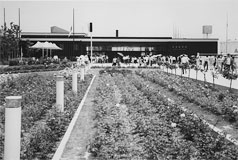
The Japan Folk Crafts Museum, Osaka is located in the cultural quarter of the Expo ’70 Commemorative Park. It is next to the Japanese Garden, the Rose Garden and the National Museum of Ethnology.
The Museum was originally established in 1970 as one of the pavilions of the Japan World Exposition, Osaka. Its purpose was to introduce the beauty of Mingei to the world, with the exhibition concept of “beauty in everyday life”.
Mingei is a Japanese word coined by the philosopher Soetsu Yanagi1 and his contemporaries to mean “folk craft of the people”. They found beauty in everyday utilitarian objects handcrafted by anonymous craftsmen using techniques that were on the verge of being rendered obsolete and replaced by mass produced industrial goods. Yanagi et al reappraised those craft works and actively promoted new modes of use and designs for these objects.
The first director of this museum was Shoji Hamada2, one of the leaders of the Mingei movement.
Ever since that time, every spring and autumn, the Museum has been holding exhibitions about folk crafts, pottery, dyeing and textiles, woodwork and lacquer, braiding and basket weaving.
- 1. Soetsu Yanagi (1889-1961)
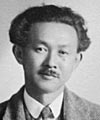 A philosopher of religion, Soetsu Yanagi was one of the founders of the Mingei movement. He was also one of the founders of a literary journal Shirakaba. He was moved by Korean crafts of the Yi dynasty, and by the slipware pottery of England and was intrigued by the beauty he found in everyday utensils. He advocated Buddhist ideas of beauty and founded the Japan Folk Crafts Museum.
A philosopher of religion, Soetsu Yanagi was one of the founders of the Mingei movement. He was also one of the founders of a literary journal Shirakaba. He was moved by Korean crafts of the Yi dynasty, and by the slipware pottery of England and was intrigued by the beauty he found in everyday utensils. He advocated Buddhist ideas of beauty and founded the Japan Folk Crafts Museum.
- 2. Shoji Hamada (1894-1978)
 The potter Shoji Hamada was one of the leaders of the Mingei movement. He studied at the Tokyo Higher Technical School (present-day Tokyo Institute of Technology) and at the Kyoto Ceramic Testing Institute. In 1920 he went to England with Bernard Leach and built a nobori-gama climbing kiln at St. Ives, Cornwall, where he experimented with Japanese raku and stoneware techniques. In 1931 he established a kiln in Mashiko, Tochigi prefecture. In 1955 he was recognized as a Living National Treasure and continued to lead the Mingei movement until his death in 1978.
The potter Shoji Hamada was one of the leaders of the Mingei movement. He studied at the Tokyo Higher Technical School (present-day Tokyo Institute of Technology) and at the Kyoto Ceramic Testing Institute. In 1920 he went to England with Bernard Leach and built a nobori-gama climbing kiln at St. Ives, Cornwall, where he experimented with Japanese raku and stoneware techniques. In 1931 he established a kiln in Mashiko, Tochigi prefecture. In 1955 he was recognized as a Living National Treasure and continued to lead the Mingei movement until his death in 1978.
Museum Shop
 The Museum Shop features a wide selection of pottery, textiles, baskets and other hand craft items from many places in Japan.
The Museum Shop features a wide selection of pottery, textiles, baskets and other hand craft items from many places in Japan.
Tamba ware (Hyogo prefecture)
 Tamba ware has a history of over 800 years and is one of the six oldest kilns in Japan.
Tamba ware has a history of over 800 years and is one of the six oldest kilns in Japan.
It became widely known after Soetsu Yanagi noted its beauty in the beginning of Showa period.
The Toshihiko kiln in particular has embodied the Mingei spirit and produced useful everyday utensils.
Shussai-gama kiln (Shimane prefecture)
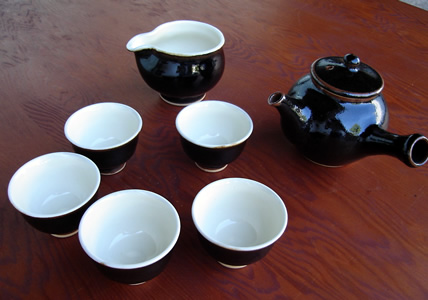 Shortly after the Second World War, a small group of young people influenced by the Mingei movement established the Shussai-gama kiln. They learned directly from the Mingei leaders, Soetsu Yanagi, Kanjiro Kawai and Bernard Leach.
Shortly after the Second World War, a small group of young people influenced by the Mingei movement established the Shussai-gama kiln. They learned directly from the Mingei leaders, Soetsu Yanagi, Kanjiro Kawai and Bernard Leach.
They use local clay to produce useful utensils with natural beauty and fine quality.
Fujina ware (Shimane prefecture)
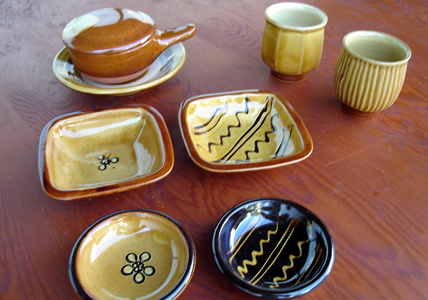 Yumachi kiln learned methodologies from one of the Mingei leaders, Bernard Leach, and mixed it with their traditional method to produce a new wave of Fujina ware with a British flavor.
Yumachi kiln learned methodologies from one of the Mingei leaders, Bernard Leach, and mixed it with their traditional method to produce a new wave of Fujina ware with a British flavor.
Onta ware (Oita prefecture)
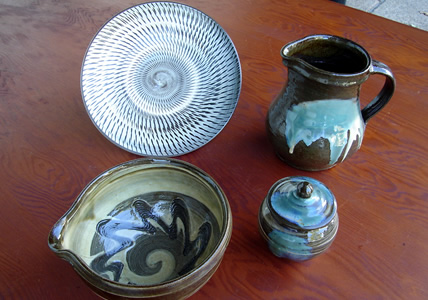 Soetsu Yanagi introduced Onta ware in his traveler’s journal ‘Hida no sara yama’
Soetsu Yanagi introduced Onta ware in his traveler’s journal ‘Hida no sara yama’
They continue to produce everyday utensils with timelessly beautiful patterns using their traditional methodologies, Hakeme (slip-brushed design), Kushime (comb pattern), Nagashi-kake (slip decoration), Tobi-kanna (chatter marks).
Tamba textiles (Hyogo prefecture)
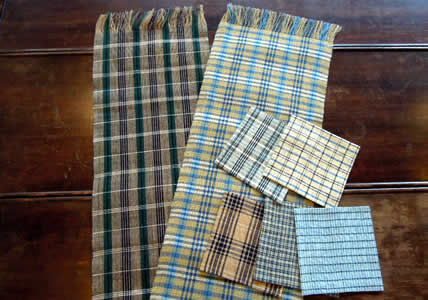 Tamba textiles with beautiful lattice patterns have traditionally been worn in Saji village (present Aogaki cho, Tamba city). Soetsu Yanagi introduced these textiles at the beginning of Showa period (early 20th century). They are made of cotton thread and dyed with vegetable dyes. They are all hand made. One of the techniques particular to Tamba textiles is the spinning of uneven thread which, when woven into cloth, adds to the beauty of its appearance.
Tamba textiles with beautiful lattice patterns have traditionally been worn in Saji village (present Aogaki cho, Tamba city). Soetsu Yanagi introduced these textiles at the beginning of Showa period (early 20th century). They are made of cotton thread and dyed with vegetable dyes. They are all hand made. One of the techniques particular to Tamba textiles is the spinning of uneven thread which, when woven into cloth, adds to the beauty of its appearance.
Tobe ware (Ehime prefecture)
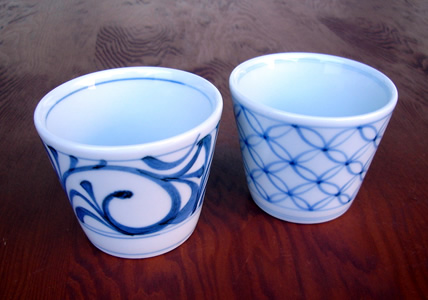 Tobe ware ceramics are produced in Tobe town using local clay originally used for making whetstones. The patterns of the Baizan-gama kiln there were directed by Soetsu Yanagi and other Mingei leaders. They produce useful everyday utensils, soba choko cups, tea cups, rice bowls and dishes.
Tobe ware ceramics are produced in Tobe town using local clay originally used for making whetstones. The patterns of the Baizan-gama kiln there were directed by Soetsu Yanagi and other Mingei leaders. They produce useful everyday utensils, soba choko cups, tea cups, rice bowls and dishes.
Iga ware (Mie prefecture)
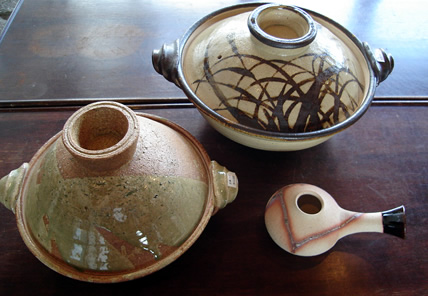 Doraku-gama kiln, an old name there, has been producing earthen ware using local clay on a potter’s wheel. These pots become more and more attractive with the patina of use.
Doraku-gama kiln, an old name there, has been producing earthen ware using local clay on a potter’s wheel. These pots become more and more attractive with the patina of use.
Lacquer ware
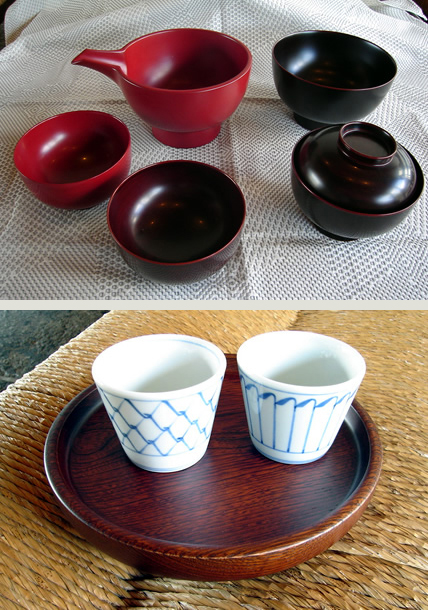 Johoji Lacquer Ware (Iwate prefecture) and Appi Lacquer Ware (Iwate prefecture) carefully produce soup bowls and trays using the finest lacquer materials and techniques.
Johoji Lacquer Ware (Iwate prefecture) and Appi Lacquer Ware (Iwate prefecture) carefully produce soup bowls and trays using the finest lacquer materials and techniques.
Mulberry paper
 Aotani town in Tottori prefecture has been making mulberry paper for over 1000 years. Dai-inshu-seishi there carries on the tradition of making papers from materials available in nature; paper mulberry, oriental paperbush and Diplomorpha sikokiana.
Aotani town in Tottori prefecture has been making mulberry paper for over 1000 years. Dai-inshu-seishi there carries on the tradition of making papers from materials available in nature; paper mulberry, oriental paperbush and Diplomorpha sikokiana.
We have a wide selection of their products, letter paper, envelopes, kaishi paper, notebooks and binders.
Hana-Mushiro rush mat (Okayama prefecture)
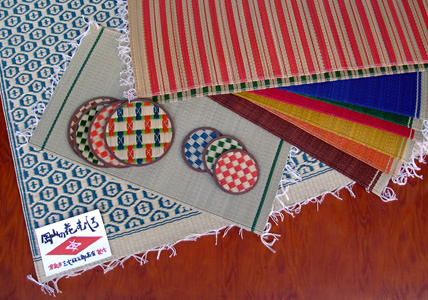 Using the finest rush cultivated in Okayama prefecture and with painstaking care Miyake Matsuzaburo Shop in Kurashiki has long been dyeing and weaving rush matting called Hana-Mushiro.
Using the finest rush cultivated in Okayama prefecture and with painstaking care Miyake Matsuzaburo Shop in Kurashiki has long been dyeing and weaving rush matting called Hana-Mushiro.
We have a wide selection of their products, Hana-mushiro mat, tablemats, pot rests and coasters with various beautiful patterns.
Access
| Access | Address : 10-5, Senri-bampaku-koen, Suita city, Osaka, Japan ・15-minute walk from Bampaku-Kinen-Koen Station on the Osaka Monorail ・15-minute walk from Koen-Higashiguchi Station on the Osaka Monorail ・15-minute walk from Nihon-Teien-Mae bus stop ・5-minute walk from the Nihon-Teien-mae parking lot |
||||||||||||||||||||||||
|---|---|---|---|---|---|---|---|---|---|---|---|---|---|---|---|---|---|---|---|---|---|---|---|---|---|
| Hours | 10:00 AM-5:00 PM (Admission until 4:30 PM) Closed on Wednesdays |
||||||||||||||||||||||||
| Admission |
|



